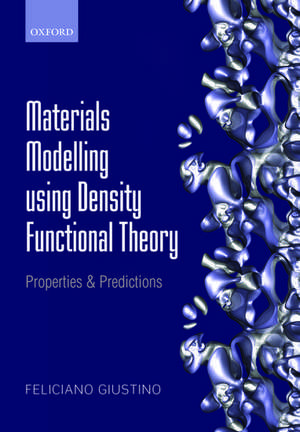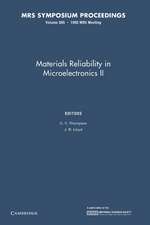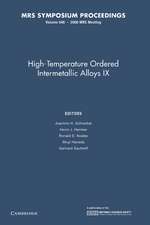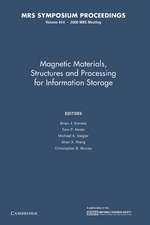Materials Modelling using Density Functional Theory: Properties and Predictions
Autor Feliciano Giustinoen Limba Engleză Paperback – 15 mai 2014
| Toate formatele și edițiile | Preț | Express |
|---|---|---|
| Paperback (1) | 296.10 lei 10-16 zile | +56.17 lei 4-10 zile |
| OUP OXFORD – 15 mai 2014 | 296.10 lei 10-16 zile | +56.17 lei 4-10 zile |
| Hardback (1) | 722.26 lei 31-37 zile | |
| OUP OXFORD – 15 mai 2014 | 722.26 lei 31-37 zile |
Preț: 296.10 lei
Preț vechi: 318.27 lei
-7% Nou
Puncte Express: 444
Preț estimativ în valută:
56.67€ • 61.53$ • 47.60£
56.67€ • 61.53$ • 47.60£
Carte disponibilă
Livrare economică 21-27 martie
Livrare express 15-21 martie pentru 66.16 lei
Preluare comenzi: 021 569.72.76
Specificații
ISBN-13: 9780199662449
ISBN-10: 0199662444
Pagini: 304
Ilustrații: 24 b/w and 42 colour illustrations
Dimensiuni: 175 x 246 x 20 mm
Greutate: 0.75 kg
Editura: OUP OXFORD
Colecția OUP Oxford
Locul publicării:Oxford, United Kingdom
ISBN-10: 0199662444
Pagini: 304
Ilustrații: 24 b/w and 42 colour illustrations
Dimensiuni: 175 x 246 x 20 mm
Greutate: 0.75 kg
Editura: OUP OXFORD
Colecția OUP Oxford
Locul publicării:Oxford, United Kingdom
Recenzii
At last an undergraduate/graduate textbook that demonstrates the power of density functional theory not only to help interpret experimental data but also to predict the properties of new materials. Each chapter is lucidly presented with heuristic, intuitive arguments leading to the main ideas before numerous examples illustrate the often remarkable accuracy of density functional theory over a wide range of electronic, structural, mechanical, optical and magnetic properties. A book that should be on the shelves of every library in Materials Science and Engineering, Physics and Chemistry departments.
The density functional theory has finally brought quantum mechanics into materials science. Its proven ability to produce correct predictions of properties of real materials means that it has taken over as the premier method in solid state materials, ultimately because of its suitability as a numerical method. While traditional books still build from analytically tractable models, this book reflects more accurately current practice. The book will be ideal for a graduate-level student with a grounding in quantum mechanics, and could be tackled in an undergraduate course.
The density functional theory has finally brought quantum mechanics into materials science. Its proven ability to produce correct predictions of properties of real materials means that it has taken over as the premier method in solid state materials, ultimately because of its suitability as a numerical method. While traditional books still build from analytically tractable models, this book reflects more accurately current practice. The book will be ideal for a graduate-level student with a grounding in quantum mechanics, and could be tackled in an undergraduate course.
Notă biografică
Feliciano Giustino is an Associate Professor of Materials Modelling in the Department of Materials at the University of Oxford, the co-Director of the Materials Modelling Laboratory, and Associate Editor of the European Physical Journal B. He holds an MSc in Nuclear Engineering from the Politecnico di Torino, a PhD in Physics from the Ecole Polytechnique Fédérale de Lausanne, and before joining the Department of Materials at Oxford he was a researcher in the Department of Physics at the University of California at Berkeley. His research team specializes in the computational modelling of nanomaterials and the development of methods for electronic structure calculations. He has been recipient of the European Research Council Starting Grant and of the Leverhulme Research Leadership Award. Besides his research work, he teaches two undergraduate courses on the quantum theory of materials at the University of Oxford.



















